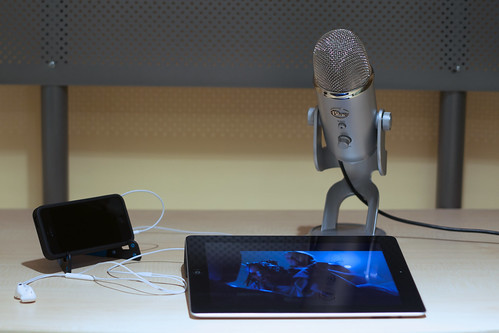Assorted thoughts and reflections on technology in education, and other things ...
Thursday, January 29, 2015
Making feedback more personal
Online education is often accused of being impersonal self-study with predominantly text-based communication that lacks the intimacy of meeting teachers and fellow students face-to-face. The discussion forums of many courses are indeed rather impersonal with many students and teachers opting not to show photos of themselves. The teacher may provide recorded lectures but generally there is very little personal contact in such environments; face-to-face contact is missing and students seldom hear the teacher addressing them directly. As a result it is extremely difficult to foster a sense of community and when interaction is limited and relatively impersonal it is no surprise that many learners simply give up or slowly fade from view. As low bandwidth has become less of an issue in recent years online learning should have been first to reap the benefits of synchronous and asynchronous audio and video communication to provide a more media-rich learning environment and enable more personal contact between students and teachers.
It is surprising therefore that we are only now beginning to exploit the use of audio and video in education. This is highlighted in an article by Steve Kolowich in the Chronicle of Higher Education, Could Video Feedback Replace the Red Pen? It describes how teachers are providing feedback on student assessments by posting short videos instead of commenting in text. The advantages of video feedback are many but above all it makes the teacher-student contact suddenly more personal, offering contact and empathy in a way that text can never convey. The article quotes student reactions to video feedback as overwhelmingly positive, claiming that the communication was real, honest and authentic in comparison with text feedback. The teacher addresses the student directly giving a few minutes of specific feedback and this can make the difference between the student opting out or staying the course. In addition teachers found it quicker and easier to make a video commentary with a mobile and any hesitations or repetition was seen by students as adding to the personal touch of the message.
Instructor feedback seems like a natural fit for video, especially because short videos have become easy for anyone to make and distribute. The Monash instructors, for example, recorded theirs with webcams and iPhones. And yet they found few documented cases of similar experiments in the research literature. Most studies have focused on videos directed at an entire class, they said, rather than ones tailored to individual students.
We should not simply focus on video either. Audio has many advantages and also offers a more personal contact than text. Recording an audio message is simple on any device and audio files can be easily embedded into a Word document or a PowerPoint slide enabling the teacher to give specific feedback on the student's work. Although it's good to see the teacher's face now and again it's often better to hear the voice while looking at the work being commented on. For students with bandwidth limitations audio feedback is not demanding and provides that direct contact between teacher and student that text fails to provide. The British organisation JISC's guide, Using Audio Feedback for Assessment, provides good advice on using audio feedback with students. They have also produced a specific guide to adding audio comments to a Word document.
Some research into the effects of student feedback on their development has brought up themes of staff effort gone to waste and students not digesting feedback, therefore hindering their development (Hartley and Skelton, 2002). As a result numerous case studies have investigated the potential for successful audio feedback to be an improvement on written feedback in the perception of students and assessors.
Audio and video can also transform the discussion forum offering students a choice in how they contribute. It also increases accessibility for students with impaired sight or dyslexia many of whom will feel much more comfortable making an audio comment than writing text. I know several teachers who use the tool VoiceThread to create discussion threads with a combination of video, audio and text communication and this gives a real voice and face to all participants who, on a more traditional online course, would never see of hear each other at all. Basically a variety of media makes a richer learning environment for all. Imaginative use of media for asynchronous communication can help to narrow the distance in online education. Soon the concept of face-to-face will not necessarily mean being in the same room. It can even be applied to asynchronous communication.
Subscribe to:
Post Comments (Atom)

The great information that you shared. It will help all of them. Thanks for posting. Keep maintain the updates Educational Services
ReplyDelete|
Online Mock Test series